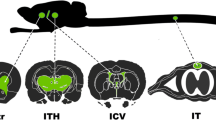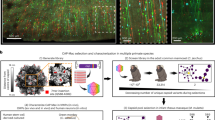Abstract
The efficient delivery of genetic material to the developing fetal brain represents a powerful research tool and a means to supply therapy in a number of neonatal lethal neurological disorders. In this study, we have delivered vectors based upon adenovirus serotype 5 (Ad5) and adeno-associated virus (AAV) pseudotypes 2/5, 2/8 and 2/9 expressing green fluorescent protein to the E16 fetal mouse brain. One month post injection, widespread caudal to rostral transduction of neural cells was observed. In discrete areas of the brain these vectors produced differential transduction patterns. AAV2/8 and 2/9 produced the most extensive gene delivery and had similar transduction profiles. All AAV pseudotypes preferentially transduced neurons whereas Ad5 transduced both neurons and glial cells. None of the vectors elicited any significant microglia-mediated immune response when compared with control uninjected mice. Whole-body imaging and immunohistological evaluation of brains 9 months post injection revealed long-term expression using these non-integrating vectors. These data will be useful in targeting genetic material to discrete or widespread areas of the fetal brain with the purpose of devising therapies for early neonatal lethal neurodegenerative disease and for studying brain development.
This is a preview of subscription content, access via your institution
Access options
Subscribe to this journal
Receive 12 print issues and online access
$259.00 per year
only $21.58 per issue
Buy this article
- Purchase on Springer Link
- Instant access to full article PDF
Prices may be subject to local taxes which are calculated during checkout






Similar content being viewed by others
References
Fritchie K, Siintola E, Armao D, Lehesjoki AE, Marino T, Powell C et al. Novel mutation and the first prenatal screening of cathepsin D deficiency (CLN10). Acta Neuropathol 2009; 117: 201–208.
Orvisky E, Sidransky E, McKinney CE, Lamarca ME, Samimi R, Krasnewich D et al. Glucosylsphingosine accumulation in mice and patients with type 2 Gaucher disease begins early in gestation. Pediatr Res 2000; 48: 233–237.
Di Domenico C, Villani GR, Di Napoli D, Nusco E, Cali G, Nitsch L et al. Intracranial gene delivery of LV-NAGLU vector corrects neuropathology in murine MPS IIIB. Am J Med Genet A 2009; 149A: 1209–1218.
Lawlor PA, Bland RJ, Mouravlev A, Young D, During MJ . Efficient gene delivery and selective transduction of glial cells in the mammalian brain by AAV serotypes isolated from nonhuman primates. Mol Ther 2009; 17: 1692–1702.
Naldini L, Blomer U, Gage FH, Trono D, Verma IM . Efficient transfer, integration, and sustained long-term expression of the transgene in adult rat brains injected with a lentiviral vector. Proc Natl Acad Sci USA 1996; 93: 11382–11388.
Bemelmans AP, Husson I, Jaquet M, Mallet J, Kosofsky BE, Gressens P . Lentiviral-mediated gene transfer of brain-derived neurotrophic factor is neuroprotective in a mouse model of neonatal excitotoxic challenge. J Neurosci Res 2006; 83: 50–60.
Broekman ML, Comer LA, Hyman BT, Sena-Esteves M . Adeno-associated virus vectors serotyped with AAV8 capsid are more efficient than AAV-1 or -2 serotypes for widespread gene delivery to the neonatal mouse brain. Neuroscience 2006; 138: 501–510.
Passini MA, Watson DJ, Vite CH, Landsburg DJ, Feigenbaum AL, Wolfe JH . Intraventricular brain injection of adeno-associated virus type 1 (AAV1) in neonatal mice results in complementary patterns of neuronal transduction to AAV2 and total long-term correction of storage lesions in the brains of beta-glucuronidase-deficient mice. J Virol 2003; 77: 7034–7040.
Passini MA, Wolfe JH . Widespread gene delivery and structure-specific patterns of expression in the brain after intraventricular injections of neonatal mice with an adeno-associated virus vector. J Virol 2001; 75: 12382–12392.
Venkatraman G, Behrens M, Pyrski M, Margolis FL . Expression of Coxsackie-Adenovirus receptor (CAR) in the developing mouse olfactory system. J Neurocytol 2005; 34: 295–305.
Walsh C, Cepko CL . Clonally related cortical cells show several migration patterns. Science 1988; 241: 1342–1345.
Rahim AA, Wong AM, Howe SJ, Buckley SM, Acosta-Saltos AD, Elston KE et al. Efficient gene delivery to the adult and fetal CNS using pseudotyped non-integrating lentiviral vectors. Gene Therapy 2009; 16: 509–520.
Kielar C, Maddox L, Bible E, Pontikis CC, Macauley SL, Griffey MA et al. Successive neuron loss in the thalamus and cortex in a mouse model of infantile neuronal ceroid lipofuscinosis. Neurobiol Dis 2007; 25: 150–162.
Decembrini S, Bressan D, Vignali R, Pitto L, Mariotti S, Rainaldi G et al. MicroRNAs couple cell fate and developmental timing in retina. Proc Natl Acad Sci USA 2009; 106: 21179–21184.
Eacker SM, Dawson TM, Dawson VL . Understanding microRNAs in neurodegeneration. Nat Rev Neurosci 2009; 10: 837–841.
Fineberg SK, Kosik KS, Davidson BL . MicroRNAs potentiate neural development. Neuron 2009; 64: 303–309.
Christensen M, Larsen LA, Kauppinen S, Schratt G . Recombinant adeno-associated virus-mediated microRNA delivery into the postnatal mouse brain reveals a role for miR-134 in dendritogenesis in vivo. Front Neural Circuits 2010; 3: 16.
Ebert MS, Neilson JR, Sharp PA . MicroRNA sponges: competitive inhibitors of small RNAs in mammalian cells. Nat Methods 2007; 4: 721–726.
Eblan MJ, Goker-Alpan O, Sidransky E . Perinatal lethal Gaucher disease: a distinct phenotype along the neuronopathic continuum. Fetal Pediatr Pathol 2005; 24: 205–222.
Mignot C, Gelot A, Bessieres B, Daffos F, Voyer M, Menez F et al. Perinatal-lethal Gaucher disease. Am J Med Genet A 2003; 120A: 338–344.
Guggenbuhl P, Grosbois B, Chales G . Gaucher disease. Joint Bone Spine 2008; 75: 116–124.
Roybal JL, Santore MT, Flake AW . Stem cell and genetic therapies for the fetus. Semin Fetal Neonatal Med; 2010; 15: 46–51.
Waddington SN, Buckley SM, David AL, Peebles DM, Rodeck CH, Coutelle C . Fetal gene transfer. Curr Opin Mol Ther 2007; 9: 432–438.
Hotta Y, Honda T, Naito M, Kuwano R . Developmental distribution of coxsackie virus and adenovirus receptor localized in the nervous system. Brain Res Dev Brain Res 2003; 143: 1–13.
Ahn J, Jee Y, Seo I, Yoon SY, Kim D, Kim YK et al. Primary neurons become less susceptible to coxsackievirus B5 following maturation: the correlation with the decreased level of CAR expression on cell surface. J Med Virol 2008; 80: 434–440.
Persson A, Fan X, Widegren B, Englund E . Cell type- and region-dependent coxsackie adenovirus receptor expression in the central nervous system. J Neurooncol 2006; 78: 1–6.
Barcia C, Jimenez-Dalmaroni M, Kroeger KM, Puntel M, Rapaport AJ, Larocque D et al. One-year expression from high-capacity adenoviral vectors in the brains of animals with pre-existing anti-adenoviral immunity: clinical implications. Mol Ther 2007; 15: 2154–2163.
Akache B, Grimm D, Pandey K, Yant SR, Xu H, Kay MA . The 37/67-kilodalton laminin receptor is a receptor for adeno-associated virus serotypes 8, 2, 3, and 9. J Virol 2006; 80: 9831–9836.
Shen S, Bryant KD, Brown SM, Randell SH, Asokan A . Terminal N-linked galactose is the primary receptor for adeno-associated virus 9. J Biol Chem 2011; 286: 13532–13540.
Masamizu Y, Okada T, Ishibashi H, Takeda S, Yuasa S, Nakahara K . Efficient gene transfer into neurons in monkey brain by adeno-associated virus 8. Neuroreport 2010; 21: 447–451.
Davidson BL, Stein CS, Heth JA, Martins I, Kotin RM, Derksen TA et al. Recombinant adeno-associated virus type 2, 4, and 5 vectors: transduction of variant cell types and regions in the mammalian central nervous system. Proc Natl Acad Sci USA 2000; 97: 3428–3432.
Liu G, Chen YH, He X, Martins I, Heth JA, Chiorini JA et al. Adeno-associated virus type 5 reduces learning deficits and restores glutamate receptor subunit levels in MPS VII mice CNS. Mol Ther 2007; 15: 242–247.
Colle MA, Piguet F, Bertrand L, Raoul S, Bieche I, Dubreil L et al. Efficient intracerebral delivery of AAV5 vector encoding human ARSA in non-human primate. Hum Mol Genet 2010; 19: 147–158.
Markakis EA, Vives KP, Bober J, Leichtle S, Leranth C, Beecham J et al. Comparative transduction efficiency of AAV vector serotypes 1-6 in the substantia nigra and striatum of the primate brain. Mol Ther 2010; 18: 588–593.
Walters RW, Yi SM, Keshavjee S, Brown KE, Welsh MJ, Chiorini JA et al. Binding of adeno-associated virus type 5 to 2,3-linked sialic acid is required for gene transfer. J Biol Chem 2001; 276: 20610–20616.
Cearley CN, Wolfe JH . Transduction characteristics of adeno-associated virus vectors expressing cap serotypes 7, 8, 9, and Rh10 in the mouse brain. Mol Ther 2006; 13: 528–537.
Waddington SN, Buckley SM, Nivsarkar M, Jezzard S, Schneider H, Dahse T et al. In utero gene transfer of human factor IX to fetal mice can induce postnatal tolerance of the exogenous clotting factor. Blood 2003; 101: 1359–1366.
Mehta AK, Majumdar SS, Alam P, Gulati N, Brahmachari V . Epigenetic regulation of cytomegalovirus major immediate-early promoter activity in transgenic mice. Gene 2009; 428: 20–24.
Zhang F, Thornhill SI, Howe SJ, Ulaganathan M, Schambach A, Sinclair J et al. Lentiviral vectors containing an enhancer-less ubiquitously acting chromatin opening element (UCOE) provide highly reproducible and stable transgene expression in hematopoietic cells. Blood 2007; 110: 1448–1457.
Husain T, Passini MA, Parente MK, Fraser NW, Wolfe JH . Long-term AAV vector gene and protein expression in mouse brain from a small pan-cellular promoter is similar to neural cell promoters. Gene Therapy 2009; 16: 927–932.
Huang H, Xue R, Zhang J, Ren T, Richards LJ, Yarowsky P et al. Anatomical characterization of human fetal brain development with diffusion tensor magnetic resonance imaging. J Neurosci 2009; 29: 4263–4273.
Zhang J, Richards LJ, Yarowsky P, Huang H, van Zijl PC, Mori S . Three-dimensional anatomical characterization of the developing mouse brain by diffusion tensor microimaging. Neuroimage 2003; 20: 1639–1648.
Foust KD, Nurre E, Montgomery CL, Hernandez A, Chan CM, Kaspar BK . Intravascular AAV9 preferentially targets neonatal neurons and adult astrocytes. Nat Biotechnol 2009; 27: 59–65.
Nicklin SA, Wu E, Nemerow GR, Baker AH . The influence of adenovirus fiber structure and function on vector development for gene therapy. Mol Ther 2005; 12: 384–393.
Von Seggern DJ, Kehler J, Endo RI, Nemerow GR . Complementation of a fibre mutant adenovirus by packaging cell lines stably expressing the adenovirus type 5 fibre protein. J Gen Virol 1998; 79 (Part 6): 1461–1468.
Nathwani AC, Gray JT, Ng CY, Zhou J, Spence Y, Waddington SN et al. Self-complementary adeno-associated virus vectors containing a novel liver-specific human factor IX expression cassette enable highly efficient transduction of murine and nonhuman primate liver. Blood 2006; 107: 2653–2661.
Nathwani AC, Davidoff A, Hanawa H, Zhou JF, Vanin EF, Nienhuis AW . Factors influencing in vivo transduction by recombinant adeno-associated viral vectors expressing the human factor IX cDNA. Blood 2001; 97: 1258–1265.
Bible E, Gupta P, Hofmann SL, Cooper JD . Regional and cellular neuropathology in the palmitoyl protein thioesterase-1 null mutant mouse model of infantile neuronal ceroid lipofuscinosis. Neurobiol Dis 2004; 16: 346–359.
Acknowledgements
We thank Gennadij Raivich, University College London (UCL) for useful discussion. The UCL-based laboratory and AHB were supported by the Biotechnology and Biological Sciences Research Council. AAR and SNW had also received support from the UK Gauchers Association. The King's College London-based laboratory was supported by the Wellcome Trust (GR079491MA), Batten Disease Family Association and the Batten Disease Support and Research Association.
Author information
Authors and Affiliations
Corresponding author
Ethics declarations
Competing interests
The authors declare no conflict of interest.
Additional information
Supplementary Information accompanies the paper on Gene Therapy website
Rights and permissions
About this article
Cite this article
Rahim, A., Wong, A., Ahmadi, S. et al. In utero administration of Ad5 and AAV pseudotypes to the fetal brain leads to efficient, widespread and long-term gene expression. Gene Ther 19, 936–946 (2012). https://doi.org/10.1038/gt.2011.157
Received:
Revised:
Accepted:
Published:
Issue Date:
DOI: https://doi.org/10.1038/gt.2011.157
Keywords
This article is cited by
-
Argininosuccinic aciduria fosters neuronal nitrosative stress reversed by Asl gene transfer
Nature Communications (2018)
-
Fetal gene therapy for neurodegenerative disease of infants
Nature Medicine (2018)
-
In utero delivery of rAAV2/9 induces neuronal expression of the transgene in the brain: towards new models of Parkinson’s disease
Gene Therapy (2017)
-
Lipoprotein lipase in hypothalamus is a key regulator of body weight gain and glucose homeostasis in mice
Diabetologia (2017)
-
Neuronal Representation of Ultraviolet Visual Stimuli in Mouse Primary Visual Cortex
Scientific Reports (2015)



